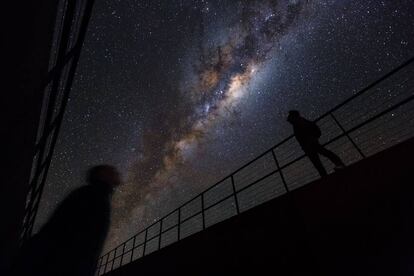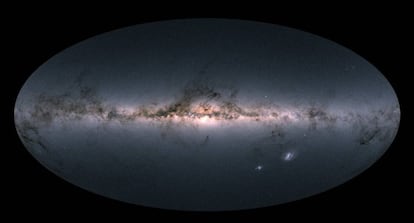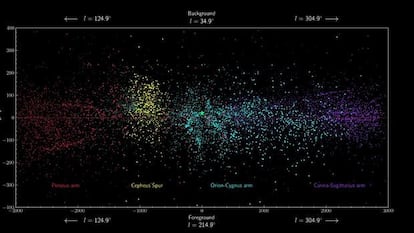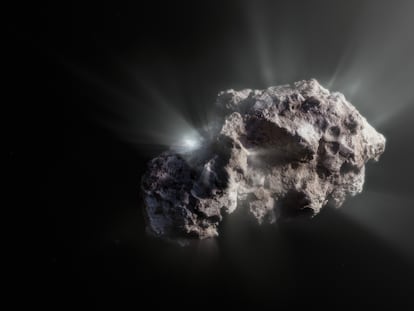Spanish astrophysicists discover new region of Milky Way
Researchers detected the Cepheus spur, a bridge of massive blue stars, while creating the most accurate map of the galaxy to date


A team of researchers from the Spanish Astrobiology Center (CAB) has presented the most accurate map of the Milky Way to date, and described the existence of the “Cepheus spur,” a formation of blue stars hotter than the sun that had remained hidden until now.
The team put together the map of the Earth’s “solar neighborhood” using the Gaia telescope of the European Space Agency, detailing the spiral arms of the stars that make up our galaxy. These include Orion, where the Solar System is located; Perseus, located at the outer edge of the galaxy, and Sagittarius, towards the center of the Milky Way.
When we discovered the spur, there was no explosive revelation, but something inside me was transformedMichelangelo Pantaleoni González, scientist from the Spanish Astrobiology Center
Scientists led by Michelangelo Pantaleoni González and Jesús Maíz Apellániz also discovered a hidden structure that they named the Cepheus spur, a bridge of massive blue stars between the Orion Arm and Perseus constellation. A blue star has at least three times the mass of the sun, and has its moniker because its intense heat means it appears blue to our eyes.
The Cepheus spur went undetected because of the previous lack of detail in the “stellar catalog” that the researchers have just updated. The new map they have drawn “has 20,000 classified celestial objects,” says Pantaleoni González. “A density of stars can be observed in a space that was apparently empty before.” Their work was published in the Monthly Notices of Britain’s Royal Astronomical Society in March.

For the scientists, one important aspect of the newly discovered spur is its consistent motion, which shows it is not a random alignment of stars but a structure sitting above the “galactic disk,” the thin, circular distribution of stars, dust and gas that often exhibit beautiful spiral patterns. This position could be caused by contractions of a kind observed in other neighboring galaxies but that had not been seen in the Milky Way. “Possibly these are oscillations of the galactic disk resulting from the convulsive evolution of the galaxy. Perhaps they are the echoes of collisions with other galaxies billions of years ago, or maybe it’s something else,” says Pantaleoni González.
The massive blue stars that make up the Cepheus spur, also known as OB stars among astrophysicists, are the galaxy’s largest, rarest and hottest stars. Of the estimated 400 billion stars in the Milky Way, less than one in a million is an OB star, so rare in fact that Pantaleoni González characterizes them as a “rare disease.”
While the temperature on the surface of a star like the sun is around 5,500ºC, OB stars can exceed 30,000ºC and their mass can be tens of times greater. Pantaleoni González explains that the relationship between the temperature of an object and the color it glows is called Planck’s law. “If we heat a piece of charcoal to over 1,000ºC we will start to see it glow a dark red color. If we heat the ember more and more, it will reach the temperature of the sun and will glow yellowish-white, and if we continue, the color of that glow will be blue,” Pantaleoni González explains. “There are jokes out there about astrophysicists burning their hands in public toilets because they don’t understand the color code of the faucets.”

For Pantaleoni González, blue stars are the most interesting objects in the universe because the nuclear reactions occurring inside them are particularly violent, meaning they produce elements that helped to build the Earth. “The elements that our planet is made of, such as silicon or the phosphorus atoms in our DNA, come mostly from the interior of stars of this type that died billions of years ago,” says the young scientist, who has not graduated yet.
Massive blue stars also create new stars when they die, releasing enormous energy in the form of a supernova, which compresses gas at very high temperatures and then bursts into a new formation. “One OB star can, in death, give life to hundreds of stars like the sun,” says Pantaleoni González.
While blue stars blaze brightly in life, they fade out fast. “Some of them barely live a couple of million years, five thousand times less than the sun’s expected lifespan,” explains the researcher. “That means they cannot have altered their position in the galaxy very much. We almost always find them near star-forming regions, where the galaxy is active, where it is alive.” His discovery, therefore, helps to understand where new stars are born, by identifying a cluster of blue stars that give birth to many more. “The new spur shows how the production of new elements is maintained and how matter is recycled in the universe. Ultimately it is directly related to the formation of planets in other stars and to the chemical bases of life,” he says.
The massive blue stars that make up the Cepheus spur are the galaxy’s largest, rarest and hottest stars
Rodolfo Barbá, co-author of the paper and professor of astrophysics at the University of La Serena in Chile, compares the task of creating galactic maps to maps of the Earth drafted in the Enlightenment era. “We cannot send space probes even to our nearest stars, but we are probing the edges of the Milky Way using the light that reaches us from distant beacons – the OB stars,” he says. We are in the age of galaxy exploration, Barbá adds, facing the same debates and problems of great explorers on Earth in the 16th and 17th centuries. “In early mapping expeditions, the Baja California peninsula seemed separate from the American continent until enough data were obtained to show that it was not an island. Now we are debating whether the galactic arm to which the sun belongs connects at some point with the other arms or whether it is just on an island.”
Pantaleoni González recounts the moment when the team found the Cepheus spur. “When we discovered the spur, there was no explosive revelation, but something inside me was transformed. That’s what draws you in and gives meaning to so much effort,” he says. “We were in front of [astrophysicist] Jesús [Apellániz]’s computer when he began to inspect this density of dots on the map. I ran to make a special diagram to see if it was consistent with the idea that there was a structure there, and it appeared.”
The young scientist alternates his university classes with work at the Spanish Astrobiology Center. He explains that Apellániz, his mentor, has an unusual research method: “Instead of drawing general conclusions by probing thousands of data, he examines case by case. This ‘artisanal’ way of working is inefficient if you are looking for obvious things, but it is extremely productive when you are looking to discover subtle clues to what nature is showing us.”
Tu suscripción se está usando en otro dispositivo
¿Quieres añadir otro usuario a tu suscripción?
Si continúas leyendo en este dispositivo, no se podrá leer en el otro.
FlechaTu suscripción se está usando en otro dispositivo y solo puedes acceder a EL PAÍS desde un dispositivo a la vez.
Si quieres compartir tu cuenta, cambia tu suscripción a la modalidad Premium, así podrás añadir otro usuario. Cada uno accederá con su propia cuenta de email, lo que os permitirá personalizar vuestra experiencia en EL PAÍS.
¿Tienes una suscripción de empresa? Accede aquí para contratar más cuentas.
En el caso de no saber quién está usando tu cuenta, te recomendamos cambiar tu contraseña aquí.
Si decides continuar compartiendo tu cuenta, este mensaje se mostrará en tu dispositivo y en el de la otra persona que está usando tu cuenta de forma indefinida, afectando a tu experiencia de lectura. Puedes consultar aquí los términos y condiciones de la suscripción digital.
More information
Archived In
Últimas noticias
Welcome to the post-religion era: The idea of Christianity as the absolute truth has become obsolete
‘I thought you would like it’: The risky sexual practice popularized by TV shows and TikTok
The digitalization of tourism: ‘They promise experiences and gave us the worst possible one’
Mexican peso defies uncertainty with forecasts of a new period of stability in 2026
Most viewed
- Sinaloa Cartel war is taking its toll on Los Chapitos
- Reinhard Genzel, Nobel laureate in physics: ‘One-minute videos will never give you the truth’
- Oona Chaplin: ‘I told James Cameron that I was living in a treehouse and starting a permaculture project with a friend’
- Why the price of coffee has skyrocketed: from Brazilian plantations to specialty coffee houses
- Silver prices are going crazy: This is what’s fueling the rally










































